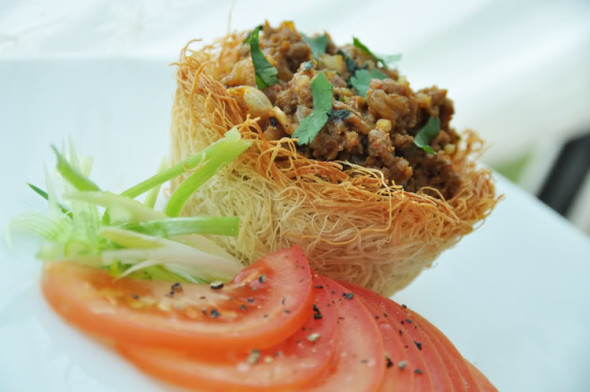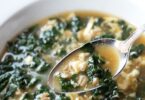Kaitifi will change your pastry-loving game. If you’ve never had a dish made with this curly, loopy pastry dough– you’ve been missing out.
The art of dough making is a very complex art. There are bread doughss, pastry doughs, pasta doughs, and basically any type of dough that you end up baking. In certain areas around the world dough making isn’t only a necessary tradition, but an art form. Kataifi, sometimes called “kadaif” or “qadaifi” is one of those special, tradition-heavy, artistic doughs that chefs around the world can’t seem to get enough of– and it’s all in the preparation.
Kataifi dough hails from Turkey, but has spent hundreds of years spreading around the world as a specialty that stretches far beyond the crisp blues of the Med. Why you ask? Because of its neutral flavor. Kataifi is made out of flour and water, a wet dough if you may, that is put through a sieve (a thin strainer) and cooked on a spinning hot plate with slits in it to give it a noodle shape. It cooks for a very short time because so the white color is preserved– going to gold or deeper yellow tones is only for latter cooking processes. Once initially cooked you can use it anyway you’d like, sweet or savory. Kataifi dough is mass produced today out of Greece in sealed air tight bags, ready to use.
“The kataifi has a neutral taste, and that is why is perfect for any kind of food,” explains Hezi Zar, a food consultant and manager at Israel’s Touch Food chain. “It absorbs flavors, so you can put it with honey and you’ve got dessert, or roll it with cheese and you got an appetizer. The dough is very simple– just flour and water. It’s the technique is what makes the kataifi so special.”
Because kataifi dough is so versatile, I will explain how to use it both ways (because that’s what friends do): sweet or savory, baked or fried. If you like sweet better, then you must go the knafeh way. What is knafeh, you ask? Well, it’s easily one of the most popular desserts in the Middle East. The traditional knafeh is made of rolled kataifi dough, a semi hard cheese that’s low in salt, pistachios, and a simple syrup infused with rose water and orange blossom. The most important thing about knafeh is that it has to be eaten within one hour of exiting the oven, mainly to preserve the crisp, crunchy integrity of the just-baked squiggly kataifi dough.
The other most popular dish you will find kataigi dough is in baklava. Have you ever seen a case full of baklava options where there’s one try made with flat, semi-shiny phyllo dough and the tray next to it has identical fillings but is encased in a bird’s nest style dough? That bird’s nest dough is kataifi, and it’s one of the most popular preparations.
Savory preparations are popular, too– especially in the culinary capitals of the Middle East. It’s not uncommon to find a small ‘next’ made of kataifi, filled with ground beef, pine nuts, and topped with raisin chutney and artisan tahini (a good recipe I devised for that dish is here). It’s an extremely versatile dough, and can be used seamlessly in just about any recipe that calls for a crisped dough component. And yes, this is totally giving you permission to rethink all your favorite brunch recipes.
READ MORE: The History of Rugelach
You can likely find kataifi dough in any Middle Eastern or Greek specialty store in frozen, raw packages. The pre-prepped stuff is often just as delicious, but lacks that just-out-of-the-oven flavor you might be seeking, so the next best option is to head to your favorite Middle Eastern or kosher restaurant to see which varieties of homemade baklava they’re offering. Hint: the pistachio is always the best.












Not only does it sound delicious, but it’s rather gorgeous as well!! Can’t wait to try this in some form soon!